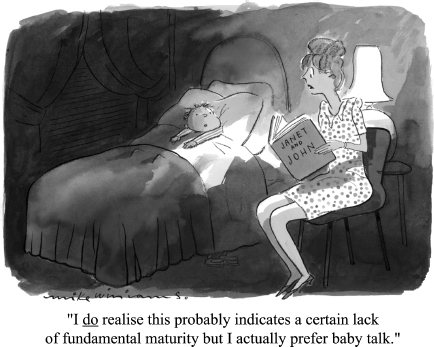Chapter 2
Preparing Your Child to Learn to Decode
You may have seen products like the video series Your Baby Can Read! that purport to teach reading skills to children as young as three months old. Actually, your baby can’t read, with or without such videos, but there are things you can do that will smooth the way once reading instruction begins years later.
Helping Your Child Hear Speech Sounds
In chapter 1, I emphasized the importance of hearing individual speech sounds. Children who come to school with that skill in place have a real edge in learning to read compared to those who don’t. But this skill doesn’t develop spontaneously. Syllables are much easier to hear than individual speech sounds. Adults who cannot read can probably tell you that CARROT and DOGGY have more syllables than SAT. But illiterate adults cannot tell you that CARROT and SAT end with the same sound, which differs from the one at the end of DOGGY. How can you help your child hear speech sounds before she can read?
Motherese
The evidence for the first method is not terribly strong, but it points to something you would probably do anyway, so I’ll mention it. You may well have heard about the scientific study of “motherese,” the somewhat precious name given to the way mothers speak to their infant children. Compared to adult speech, motherese is spoken more slowly and at a higher pitch. The grammar is simpler, and the prosody is exaggerated. (Prosody is the sort of melody of speech, including features like tone and pacing. For example, in English, a rising pitch at the end of a sentence signals a question.)
Parents speaking motherese probably help their children learn to talk by providing a very clear model of speech. And perhaps because of its slow pace and clarity of enunciation, motherese may give children an advantage in hearing speech sounds years later (figure 2.1).

Figure 2.1. Motherese. Speaking to children in motherese helps children learn to speak and is not talking down to children. But there does come a time that the child is ready for adult speech.
Source: © Mike Williams, via CartoonStock.
Wordplay
The evidence is much stronger for the second method: wordplay that highlights individual speech sounds. In some instances, the child listens to others engaged in such play; those activities can begin as early in life as you care to start. Other games require that your child produces some wordplay on her own. You’ll probably want to start those at age four or five, or earlier, if your child catches on to the idea. Here are some examples of word games that help children to hear individual speech sounds:
These sorts of word games do more than help kids hear speech sounds. They also show your children that you’re interested in language: you find it fun and worthy of close attention.
Don’t get frantic about ensuring enough “practice” with these games. There’s lots of research on classroom instructional programs that have kids practice tasks that boost awareness of speech sounds. The exercises tend to be straightforward questions like asking, “Do ‘can’ and ‘man’ rhyme?” or, “Can you squish together ‘ssss,’ ‘aaaa,’ and ‘tuh’ and tell me what word it makes?” Researchers estimate that for most children, a total of twenty or twenty-five hours of such tasks (with feedback) is sufficient.
Learning Letters
As long as you’re working on sounds, should you also teach your four-year-old the letters of the alphabet? It seems as if learning the alphabet would probably be hard for children, so maybe it would be good to start early. It seems hard simply because, as noted in chapter 1, letters look so confusable. When you think about it, it seems odd that they aren’t more distinct (figure 2.2).

Figure 2.2. Distinctive letters. Letters could be closed figures made of straight line segments (like the two at the left) or they could include line segments that do not touch (like the two at the right). Our Roman alphabet includes neither sort.
Source: © Daniel Willingham.
Still, although letters look confusable and kids do mix them up, most kids get it with some practice. But is there any advantage to learning letters before reading instruction begins in kindergarten?
Teaching Letter Names
The research on this question is not completely straightforward. On the one hand, the kids who come to kindergarten knowing their letters are the ones who end up being better readers later, and that finding has been known for decades. On the other hand, teaching kids their letters early doesn’t seem to give them much of an edge in reading. Why? The obvious answer would be that knowing letters doesn’t actually help; letter knowledge and reading success are associated because knowing the letters happens to go along with some other knowledge that is helping kids with reading. One possibility is that kids get a head start on knowing the letter-sound associations through letter names. No one really knows, but it seems to me that learning letters at home shouldn’t be something you overworry about.
Print Referencing
If you still like the idea of your child learning letters, there are ways other than explicit instruction that you can make that happen. The one with the best research base is print referencing, a way of reading a book aloud to your child. In typical read-alouds, kids gain very little knowledge about letters. They don’t learn letter names, or the sounds they are associated with, or what letters look like. Why? Because even if the words are visible, eye-tracking studies show that kids don’t look at letters during read-alouds. They look at pictures.
In print referencing, the adult draws the child’s attention to print. Some techniques are explicit. You might make a request (e.g., “Can you show me where on the page I should start reading?”) or a comment (e.g., “Look; these two words are exactly the same”). The adult also draws the child’s attention to print implicitly by pointing to the words as he reads them.
There is good evidence that children learn about print when they are read to this way. I believe the data—I think print referencing works—but I’m nevertheless not a big fan of print referencing. Whether you’re a toddler or an adult, you can’t think of different things at the same time. If you’re thinking about letters, you’re not following the story. I’d rather the child thought about the story. Obviously, if it’s an alphabet book, the letters are the story. And my general orientation will always be trumped by the child’s interest: if he shows any interest in the print, by all means talk about the print.
Letters in the Wild
Rather than talk about letters during reading time, I’d rather talk about letters when we can focus on the idea of letters alone. Your child is surrounded by print: on stop signs, cereal boxes, and familiar logos like Disney or Lego (figure 2.3).

Figure 2.3. Letters and logos. Telling your child about the letters in logos like the “M” in McDonald’s is an easy way to make her aware that she’s surrounded by print.
Source: © Mike Mozart via Flickr.
How can you get started in exploiting all the print in your child’s world? The foundational idea is that you can gain information from print: Mommy knows where to get off the highway because the green signs with the white shapes tell her where things are. How does Daddy know this cereal has a lot of sugar in it? He read the box. Next, your child might come to see that it’s the letters that carry meaning. They have nonarbitrary shapes and are arranged in a particular order. Your child might deduce these facts on his own, but there’s no reason not to point them out when you’re stuck in line at Costco and he remarks on the sign.
Once your child gets the basic idea—reading carries meaning, and does so through letters—there is no end to the games you can play. I mean sure, get them blocks with letters on them, get them letter refrigerator magnets, get them alphabet board books . . . but also be opportunistic about times and places that letters can sneak into your child’s day. Make letters in the mud with a stick when you take a breather on a hike. Draw the Batman logo and a “B” in the steam on the bathroom mirror. Make everyone a pancake in the shape of his or her first initial. Stopped at a red light: “Let’s see how many ‘t’s we can see on the signs around here before the light turns green.” If you prompt interest in letters in these daily interactions, it’s that much more likely your child will show interest in letters during read-alouds.
When Should Reading Instruction Start?
As with learning letters, there are some twists and turns in the research on this question. I said in chapter 1 that there is more consistency in the mapping between letters and sounds than is first apparent. But that doesn’t mean that all of those rules are easy to learn. Yes, we can make sense of the fact that “c” is sometimes pronounced S and sometimes K: it’s the former when it’s followed by “e,” “i,” or “y” (e.g., CENT, CINCH, or CYCLE) and the latter when followed by other vowels (e.g., CAT, COLLAR, or CULPRIT). But even if there’s a rule to explain the inconsistency, learning would be simpler if it were always pronounced the same way.
The complexity of the code in English is a problem for beginning readers that kids learning to read other languages don’t face because the letter-sound mapping is simpler. Finnish and Italian, for example, are very consistent, with a near one-to-one mapping between letters and speech sounds. Kids learn to decode quite quickly in those countries. In a matter of months, most children can read aloud one- or two-syllable words with few errors. English-speaking children lag far behind (figure 2.4).

Figure 2.4. Reading proficiency in European countries. The numbers are the average percentages of one-syllable words that children can read correctly at the end of first grade. Portuguese, French, and Danish, like English, have less consistent mappings between sounds and letters than other languages do.
Source: © hektoR, Shutterstock. Modified from the original. Percentages from Seymour, Aro, and Erskine (2003).
Learning to decode is harder in English, so it’s natural to say, “Start early!” I don’t think there’s anything wrong with this idea, but there are some data indicating that starting as early as five years old or as late as seven doesn’t end up making much difference. Of course, kids who start earlier will be better readers at age eight, but the difference is pretty much gone by age eleven. Why does the advantage disappear so quickly? Because kids who start earlier learn to decode earlier. But by age eleven, everyone, including the late starters, is a good decoder. For that reason, reading tests for eleven-year-olds also change; there’s no point in measuring decoding because everyone is pretty good at it. Instead, reading tests emphasize comprehension, which, we saw in chapter 1, depends heavily on background knowledge. So having learned to decode at a younger age doesn’t provide an edge.
Thus, I wouldn’t look for a preschool that proudly proclaims that it starts reading instruction at age four in order to give kids a head start. Rather, I’d look for a preschool that is sensitive to where my child is and has the flexibility to adapt. If my child is weak in hearing speech sounds, I’d rather she work on that for a while. Then again, if my child shows interest in learning to read, I’d like the school to support her interest.
When it comes to reading and preschools, I’d be more concerned about opportunities for my child to learn about the world than to learn about the alphabet. By age nine or so, your child will likely be a competent decoder. When that happens, his ability to comprehend what he reads will depend heavily on his background knowledge. The time to begin that learning is not, however, at age nine. The time to begin is infancy. So let’s get cracking.
Notes
“Actually, your baby can’t read, with or without such videos”: Neuman, Kaefer, Pinkham, and Strouse (2014).
“Parents speaking motherese probably help their children learn to talk”: Nelson, Hirsh-Pasek, Jusczyk, and Cassidy (1989).
“motherese may give children an advantage in hearing speech sounds”: Silvén, Niemi, and Voeten (2002).
“a total of twenty or twenty-five hours of such tasks (with feedback) is sufficient”: National Institute of Child Health and Human Development (2000).
“the kids who come to kindergarten knowing their letters are the ones who end up being better readers later”: Chall (1967); Noel Foulin (2005).
“teaching kids their letters early doesn’t seem to give them much of an edge in reading”: Piasta and Wagner (2010).
“a head start on knowing the letter-sound associations through letter names”: Treiman and Kessler (2003).
“typical read-alouds, kids gain very little knowledge about letters”: Evans, Shaw, and Bell (2000); Hood, Conlon, and Andrews (2008).
“eye-tracking studies show that kids don’t look at letters”: Justice, Skibbe, Canning, and Lankford (2005).
“children learn about print when they are read to this way”: For a review, see Justice and Pullen (2003).
“Your child is surrounded by print”: Neumann, Hood, Ford, and Neumann (2011).
“They have non-arbitrary shapes”: Levy, Gong, Hessels, Evans, and Jared (2006).
